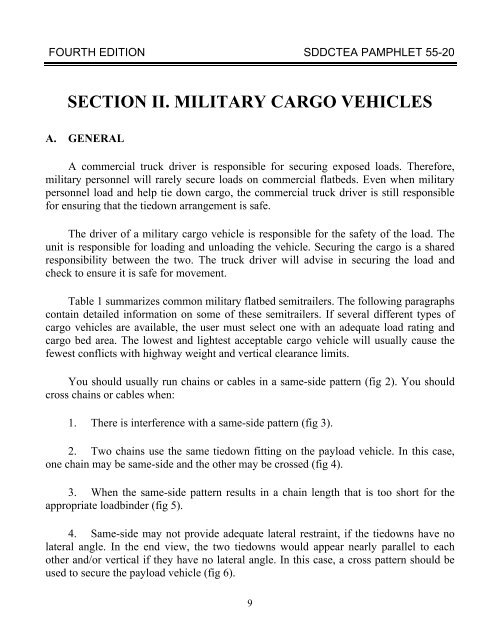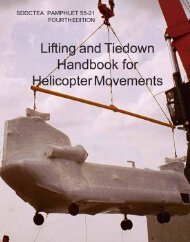TEA PAM 55-20 Tiedown Handbook for Truck - Military Surface ...
TEA PAM 55-20 Tiedown Handbook for Truck - Military Surface ...
TEA PAM 55-20 Tiedown Handbook for Truck - Military Surface ...
Create successful ePaper yourself
Turn your PDF publications into a flip-book with our unique Google optimized e-Paper software.
FOURTH EDITION SDDC<strong>TEA</strong> <strong>PAM</strong>PHLET <strong>55</strong>-<strong>20</strong><br />
SECTION II. MILITARY CARGO VEHICLES<br />
A. GENERAL<br />
A commercial truck driver is responsible <strong>for</strong> securing exposed loads. There<strong>for</strong>e,<br />
military personnel will rarely secure loads on commercial flatbeds. Even when military<br />
personnel load and help tie down cargo, the commercial truck driver is still responsible<br />
<strong>for</strong> ensuring that the tiedown arrangement is safe.<br />
The driver of a military cargo vehicle is responsible <strong>for</strong> the safety of the load. The<br />
unit is responsible <strong>for</strong> loading and unloading the vehicle. Securing the cargo is a shared<br />
responsibility between the two. The truck driver will advise in securing the load and<br />
check to ensure it is safe <strong>for</strong> movement.<br />
Table 1 summarizes common military flatbed semitrailers. The following paragraphs<br />
contain detailed in<strong>for</strong>mation on some of these semitrailers. If several different types of<br />
cargo vehicles are available, the user must select one with an adequate load rating and<br />
cargo bed area. The lowest and lightest acceptable cargo vehicle will usually cause the<br />
fewest conflicts with highway weight and vertical clearance limits.<br />
You should usually run chains or cables in a same-side pattern (fig 2). You should<br />
cross chains or cables when:<br />
1. There is interference with a same-side pattern (fig 3).<br />
2. Two chains use the same tiedown fitting on the payload vehicle. In this case,<br />
one chain may be same-side and the other may be crossed (fig 4).<br />
3. When the same-side pattern results in a chain length that is too short <strong>for</strong> the<br />
appropriate loadbinder (fig 5).<br />
4. Same-side may not provide adequate lateral restraint, if the tiedowns have no<br />
lateral angle. In the end view, the two tiedowns would appear nearly parallel to each<br />
other and/or vertical if they have no lateral angle. In this case, a cross pattern should be<br />
used to secure the payload vehicle (fig 6).<br />
9





